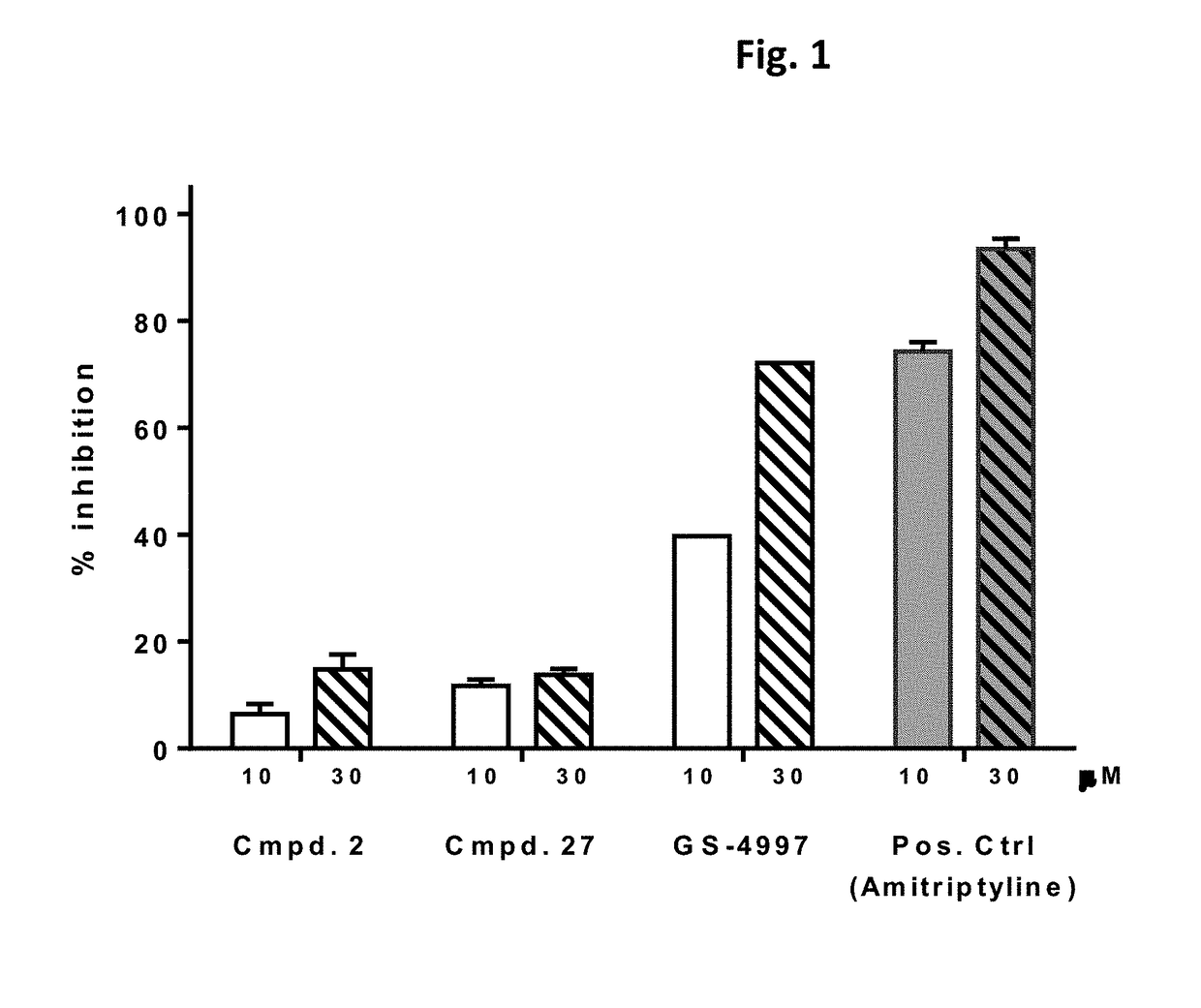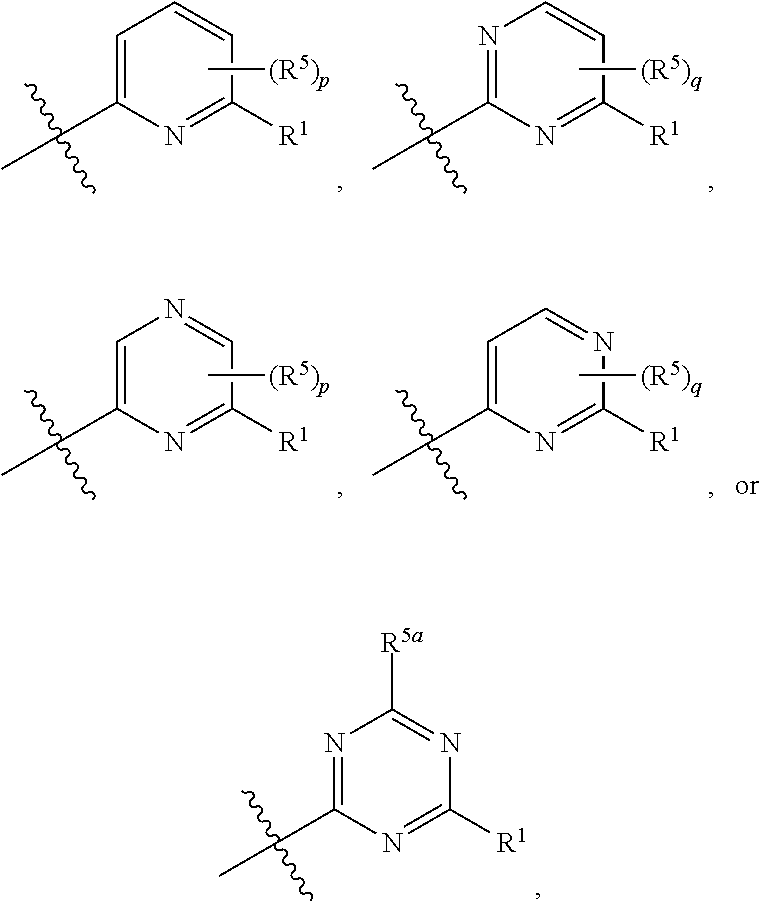Ask1 inhibitor compounds and uses thereof
a technology of aspirin and inhibitor compounds, applied in the field of aspirin inhibitor compounds, can solve problems such as liver failure or death
- Summary
- Abstract
- Description
- Claims
- Application Information
AI Technical Summary
Benefits of technology
Problems solved by technology
Method used
Image
Examples
example 1
on of 2-(6-(4-Cyclopropyl-4H-1,2,4-triazol-3-yl)pyridin-2-yl)isoindolin-1-one (compound 1)
[0385]
[0386]Hydrazine hydrate (1.16 mg, 23.1 mmol, 10 eq) was added to a solution of methyl 6-bromopicolinate (500 mg, 2.31 mmol, 1.0 eq) in MeOH (15 mL) at room temperature, then the reaction was stirred for 1 hour. The reaction mixture was concentrated under reduced pressure to give the desired hydrazide product 1A which was used without further purification: 1H NMR (400 MHz, CDCl3) δ 8.84 (s, 1H), 8.12 (d, J=7.5 Hz, 1H), 7.71 (t, J=7.7 Hz, 1H), 7.62 (d, J=7.9 Hz, 1H), 4.10 (br s, 2H).
[0387]A solution of 1B (500 mg, 2.31 mmol, 1.0 eq) and DMF-DMA (1.38 g, 11.6 mmol, 5.0 eq) in DCM (10 mL) was refluxed for 6 hours. After cooling, the reaction mixture was concentrated under reduced pressure to give the desired product 1C which was used in the subsequent step without any further purification.
[0388]Cyclopropylamine (396 mg, 6.93 mmol, 3.0 eq) was added to a stirred solution of 1C (630 mg, 2.31 mm...
example 2
on of 2-(6-(4-Cyclopropyl-4H-1,2,4-triazol-3-yl)pyridin-2-yl)-N,N-dimethyl-1-oxoisoindoline-5-carboxamide (compound 2)
[0390]
[0391]A stirred mixture of 1-oxoisoindoline-5-carboxylic acid (200 mg, 1.13 mmol, 1.0 eq), dimethylamine hydrochloride (138 mg, 1.69 mmol, 1.5 eq), EDCI (324 mg, 1.69 mmol, 1.5 eq), DMAP (276 mg, 2.26 mmol, 2.0 eq) in DMF (20 mL) and DCM (20 mL) was stirred at room temperature overnight under a nitrogen atmosphere. The reaction mixture was concentrated under reduced pressure and purified by silica gel chromatography (30%-100% EtOAc in PE) to give 2A (140 mg, 61% yield): 1H NMR (400 MHz, CDCl3) δ 7.91 (d, J=7.8 Hz, 1H), 7.55 (s, 1H), 7.50 (d, J=7.9 Hz, 1H), 6.68 (s, 1H), 4.49 (s, 2H), 3.06 (d, J=65.0 Hz, 6H).
[0392]Compound 2 was synthesized according to the procedure for compound 1 substituting intermediate 2A in place of isoindolin-1-one to give the product in 43% yield: 1H NMR (400 MHz, CDCl3) δ 8.76 (d, J=8.1 Hz, 1H), 8.37 (s, 1H), 8.03-7.89 (m, 3H), 7.63 (s,...
example 3
on of 6-chloro-2-(6-(4-cyclopropyl-4H-1,2,4-triazol-3-yl)pyridin-2-yl)-5-(morpholine-4-carbonyl)isoindolin-1-one (compound 26)
[0394]
[0395]Bromine (7.43 mL, 0.14 mol) was added dropwise to a −12° C. suspension of dimethyl 2-aminoterephthalate (25.0 g, 0.12 mol) and pyridine (19 mL, 0.24 mol) in dichloromethane (500 mL) over 1 hour. After the addition, the reaction mixture was allowed to warm to ambient temperature and stirred overnight. The mixture was concentrated and the residue was recrystallized from 95% ethanol to give compound 3A (20 g, 58% yield) as a yellow solid: 1H NMR (400 MHz, CDCl3) δ 8.09 (s, 1H), 7.05 (s, 1H), 3.90 (d, J 10.8 Hz, 6H), 1.59 (s, 2H); ESI m / z 289.2, 291.2 [M+1]+.
[0396]A mixture of 3A (20.0 g, 69.4 mmol), zinc (II) cyanide (9.37 g, 83.3 mmol) and tetrakis(triphenylphosphine)palladium(0) (4.0 g, 3.47 mmol) was suspended in DMF (200 mL) and the reaction mixture was degassed and purged with argon. The reaction mixture was heated at 120° C. for 1 hour and then...
PUM
| Property | Measurement | Unit |
|---|---|---|
| temperature | aaaaa | aaaaa |
| temperature | aaaaa | aaaaa |
| temperature | aaaaa | aaaaa |
Abstract
Description
Claims
Application Information
 Login to View More
Login to View More - R&D
- Intellectual Property
- Life Sciences
- Materials
- Tech Scout
- Unparalleled Data Quality
- Higher Quality Content
- 60% Fewer Hallucinations
Browse by: Latest US Patents, China's latest patents, Technical Efficacy Thesaurus, Application Domain, Technology Topic, Popular Technical Reports.
© 2025 PatSnap. All rights reserved.Legal|Privacy policy|Modern Slavery Act Transparency Statement|Sitemap|About US| Contact US: help@patsnap.com



